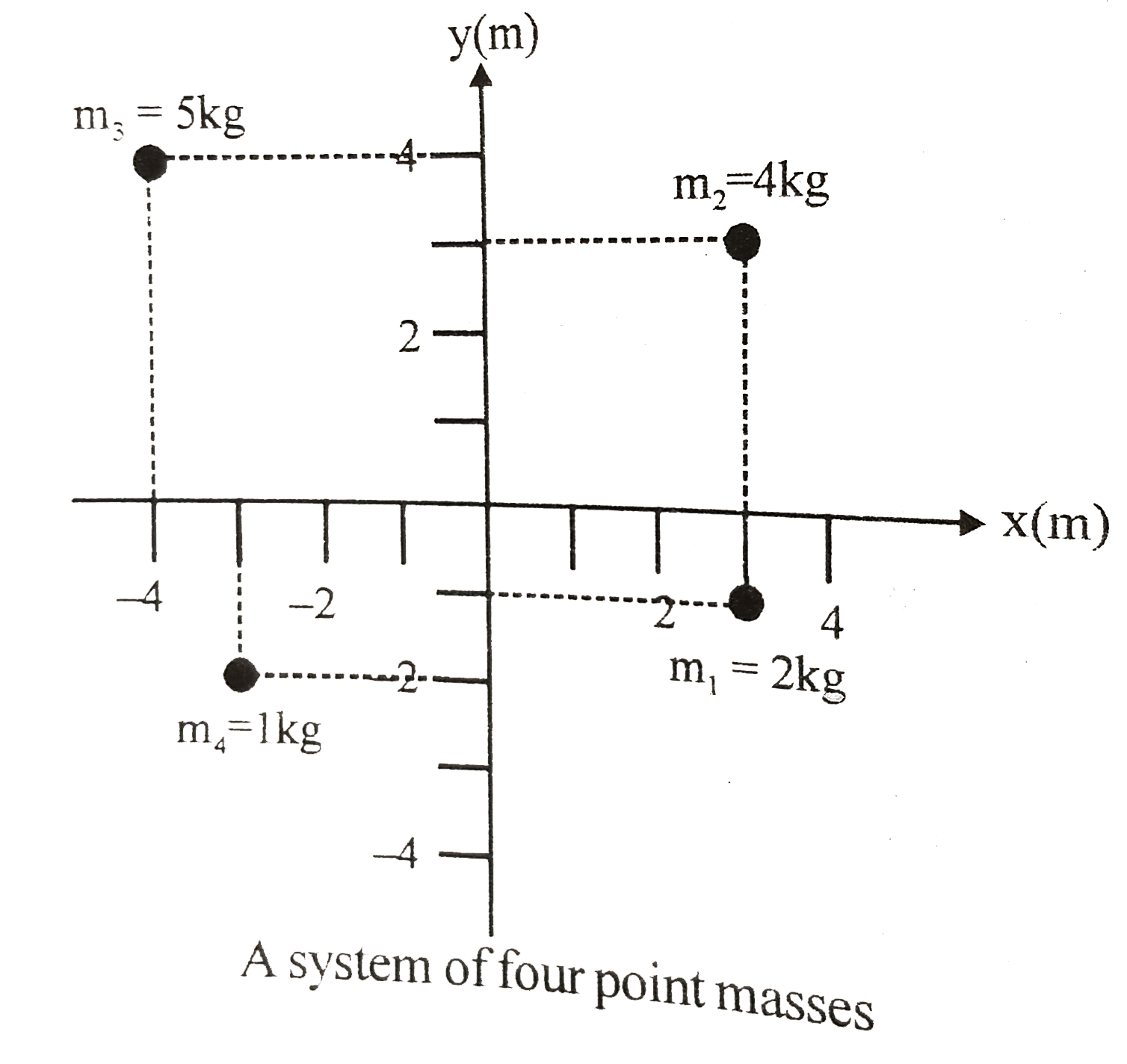Each of the four corners of a square with edge a is occupied by a point mass m. There is a fifth mass, also m, at the center of the square. To remove the mass from the center to a point far away the work that must be done by an external agent is given by:
4Gm2/a
−4Gm2/a
4√2Gm2/a
−4√2Gm2/a
The correct Answer is:C
To solve the problem of calculating the work done by an external agent to remove the mass m from the center of a square with four other masses m at the corners, we can follow these steps:
Step 1: Understand the Configuration
We have a square with edge length a. There are four point masses m located at each corner of the square and one mass m at the center of the square.
Step 2: Calculate the Initial Potential Energy
The initial potential energy Ui of the system can be calculated by considering the gravitational potential energy between all pairs of masses.
1. Pairs Involving the Center Mass: The center mass interacts with each of the four corner masses. The distance from the center to any corner is given by:
r=a√2
The potential energy between the center mass and one corner mass is:
Uc=−Gm2r=−Gm2a√2=−Gm2√2a
Since there are four corner masses, the total potential energy due to these interactions is:
Uc total=4(−Gm2√2a)=−4Gm2√2a
2. Pairs Among Corner Masses: The potential energy between each pair of corner masses can be calculated. The distance between any two corner masses (adjacent corners) is a and for diagonal corners, it is √2a. The total potential energy among the corner masses can be calculated as follows:
- For adjacent pairs (4 pairs):
Uadj=4(−Gm2a)=−4Gm2a
- For diagonal pairs (2 pairs):
Udiag=2(−Gm2√2a)=−2Gm2√2a
Combining these, the total initial potential energy Ui is:
Ui=−4Gm2√2a−4Gm2a−2Gm2√2a
Step 3: Calculate the Final Potential Energy
When the center mass m is moved to a point far away, it no longer interacts with the corner masses. Therefore, the final potential energy Uf is simply:
Uf=−4Gm2a−2Gm2√2a
Step 4: Calculate the Work Done
The work done W by the external agent is the change in potential energy:
W=Uf−Ui
Substituting the values of Uf and Ui gives us the final expression for the work done.
Final Expression
After simplifying the above expressions, we can find that the work done is:
W=−4Gm2√2a+4Gm2a+2Gm2√2a
This will yield a specific numerical value based on the constants involved.
We have a square with edge length a. There are four point masses m located at each corner of the square and one mass m at the center of the square.
The initial potential energy Ui of the system can be calculated by considering the gravitational potential energy between all pairs of masses.
r=a√2
The potential energy between the center mass and one corner mass is:
Uc=−Gm2r=−Gm2a√2=−Gm2√2a
Since there are four corner masses, the total potential energy due to these interactions is:
Uc total=4(−Gm2√2a)=−4Gm2√2a
- For adjacent pairs (4 pairs):
Uadj=4(−Gm2a)=−4Gm2a
- For diagonal pairs (2 pairs):
Udiag=2(−Gm2√2a)=−2Gm2√2a
Ui=−4Gm2√2a−4Gm2a−2Gm2√2a
When the center mass m is moved to a point far away, it no longer interacts with the corner masses. Therefore, the final potential energy Uf is simply:
Uf=−4Gm2a−2Gm2√2a
The work done W by the external agent is the change in potential energy:
W=Uf−Ui
Substituting the values of Uf and Ui gives us the final expression for the work done.
After simplifying the above expressions, we can find that the work done is:
W=−4Gm2√2a+4Gm2a+2Gm2√2a
This will yield a specific numerical value based on the constants involved.
Similar Questions
Knowledge Check
- Question 1 - Select One or More
A small mass m is moved slowly from the surface of the earth to a height h above the surface. The work done (by an external agent) in doing this is
Amgh, for all values of hBmgh, for h<<RC1/2 mgR for h=RD−1/2mgR for h=R - Question 2 - Select One
A small mass m is moved slowly from the surface of the earth to a height h above the surface. The work done (by an external agent) in doing this is
Amgh, for all values of hBmgh, for h<<RC1/2,mgR, for h=RD−1/2mgR, for h=R - Question 3 - Select One or More
A small mass m is moved slowly from the surface of the earth to a height h above the surface. The work done ( by an external agent) in doing this is
Amgh, for all values of hBmgh, for h<<RC12mgR for h = RD−12mgR, for h = R
Four point charges of +1μc each are placed on the four corners of a square of side 1 m. Calculate the electric potential at the centre of the square.
View SolutionTwo particles, each of mass m, are a distance d apart. To bring a third particle, also having mass m, from far away to the point midway between the two particles an external agent does work given by:
View SolutionFour point charge are placed at the corners of a square with diagonal 2a as shown. What is the total electric field at the center of the squre?
 View Solution
View SolutionFour particles each of mass m are placed at the vertices of a square of side l. the potential at the centre of square is
View SolutionFour equal masses (each of mass M) are placed at the corners of a squares side a the escape velocity of a body from the centre O of the square is
View Solution


